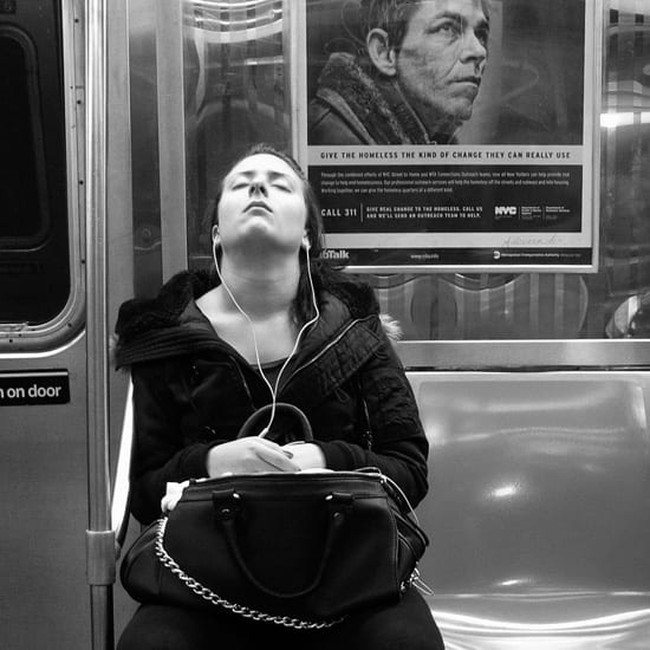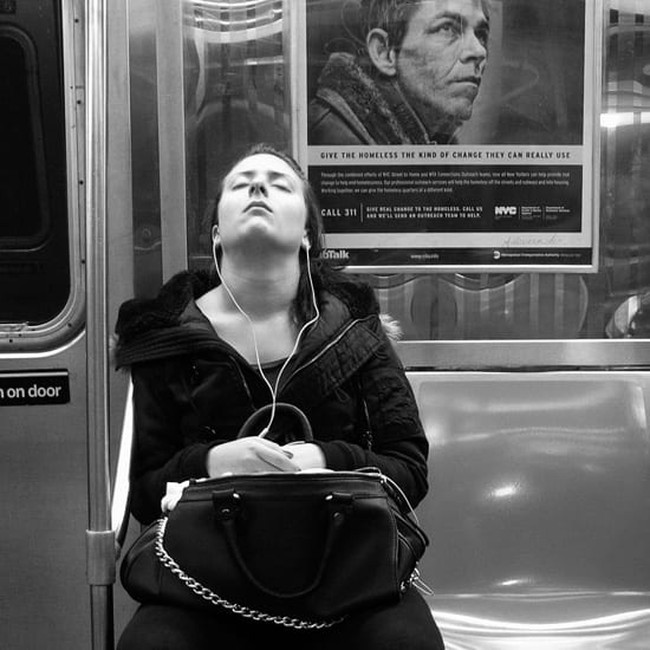Dear Belladonna Rogers:
My wife and I visited our daughter and grandchildren in Brooklyn last week. I’m 68 and know New York well, having worked there for years. Even so, sometimes I need to ask directions, especially on the subway. On this trip, as on others, I had to tap a shoulder or wave to get someone who looked reasonably approachable to remove his earbuds long enough to answer my question. Must everyone now be attached to these devices whenever they leave home?
I’m not from another planet. I, too, use an iPad, an iPhone, a MacBook Pro and an iPod. I listen when I exercise. But my earbuds aren’t in all the time. And I’m no Luddite. I’ve worked in the tech sector for decades. Why do you think I feel troubled seeing these earbuds everywhere, day and night? Am I wrong to be disturbed by them?
Music-lover in Minneapolis
Dear Music-lover,
The scene you describe, where any stranger you’d consider approaching on a subway platform is enveloped in his or her own earbudded world is, as you know, a widespread phenomenon, particularly among the young. While listening to music is one of life’s greatest joys, what’s disturbing is that the technology of light-weight, portable players not only entertains but also isolates the listeners, making them appear uncaring of, or at least disconnected from, others.
While music can help people cope with anxiety, boredom, loneliness, and pain, the constant use of earbuds actually creates two different problems, both serious. Earbud People become unapproachable by others and, at the same time, are cut off from their own innermost thoughts.
THE MESSAGE OF EARBUDS: “KEEP OUT”
Your discomfort around Earbud People may stem from your sense that — either purposely or inadvertently — they’re behaving hostilely and rudely, insisting that you keep out of their world even though you and they share a common public space.
In the past there existed an implicit social contract in public: We’re all in this together. We’ll help each other if needed.
No longer. It’s as if the Earbud People are wearing “Do Not Disturb” signs. Their eyes are often closed, absenting themselves even further from those around them. This used to be one of the functions of sunglasses indoors and on subways — to say, “I’m not here. I’m inaccessible, so buzz off.” Earbud People are cut off from others who might serendipitously begin a conversation with them. They’re thus preventing not only unwanted human contact but also the potential of positive contact.
In earlier times, merely by looking away from the gaze of another person, at the ground, or by reading in public, one could signal “Do Not Disturb.” But not everyone did it. There were always many people who were accessible and ready to give directions, talk about the likelihood of rain, or speculate about when the next train might arrive.
You’re not alone in finding this conduct anti-social and disturbing. While the users of these listening devices may not intend to convey hostility, they do.
Earbud People get much less out of every subway trip — and out of life in general — than they would without their earbuds. Once we’re in public we can benefit from being open to others.
Another aspect of the public behavior of Earbud People that many find annoying is that they act as if they have no responsibilities to their fellow citizens – including, of course, to you, when you sought a knowledgeable, approachable person for directions. So, too, when Earbud People walk down a sidewalk, with their glassy eyes staring straight ahead, they fail to notice an elderly or handicapped person who could use a helping hand crossing a busy street. They retreat into themselves like snails:
The effortless portability of music, and its capacity for ensconcing listeners in full concert-quality sound wherever they go, has other troubling consequences. As reported repeatedly (for example, here, here, and here) the hearing of one in five adolescents is now seriously impaired, with many suffering the kinds of hearing deficits typical of much older people. And their hearing loss is irreversible, leading to learning problems at school and difficulties in social interactions.
THE DECLINE OF THINKING
Earbuds not only cut off interactions with other people, they also disengage their users from a vital part of themselves. They block one of the most important human activities: thinking.
Thinking is an important part of living. And there are so many kinds to do: creative thinking, problem-solving thinking, memory-reinforcing thinking, daydreaming, planning, thinking about hopes for the future and how to realize them, thinking about books or movies and what their messages have meant to us, thinking about people in our lives and how we can see them more frequently — or less — thinking about a future event that we’d like to organize, thinking about a campaign that we’re part of and how we can best contribute to its success, thinking back on enjoyable moments and forward to ones we anticipate with excitement.
Is it not possible to do any of that thinking with the volume turned up so high that the person sitting next to you hears the words of your songs? No. Must everyone think? Evidently not. It is good exercise for your brain, however, and many who fear early-onset dementia could help themselves by actively thinking. Watching any kind of screen, except a blank one, is not active thinking. Thinking is active thinking.
An Earbud Person could counter by asking how much such thought is possible on a subway car, a train, or a bus. That I can answer with certainty: a lot. As much as in a shower? Probably not, but a shower is, for most thinking people, an extraordinary environment in which to think: the water is a form of white noise, and the muscular relaxation can free the mind to be exceptionally creative. But just because thinking on public transportation isn’t ideal doesn’t make it impossible.
THE DEATH OF SOLITUDE
By robbing themselves of easy accessibility to others and, equally seriously, depriving themselves of the chance to focus their own thoughts in a useful way, Earbud People exist in a zombified zone that is neither communal (with the chance to interact with others) nor the condition of true solitude (with the chance to be alone with their thoughts).
In generations past, when students or young people gathered in large areas, walking between classroom buildings at a high school, on a military base or college campus, they had three options: they could walk with one or two friends, with a larger crowd, or alone. If they chose either of the first two options, they reaped the rewards of sociability: they teased one another, they discussed interesting points of the class they’d just attended, they kidded around or shot the breeze. They were practicing and honing social skills.
Those who chose to walk alone had a chance to think. To think creatively or to mull over an idea. Whatever else they did, all young people could also hear birds, traffic sounds, and shouted greetings from a distance from a friend. They were — whether involved in conversations or immersed in solitude — vitally aware of their surroundings. They certainly weren’t screening them out.
Many of us did our best thinking while walking from one place to another.
Now that the Earbud People have invaded, they’ve taken over subways, academia, buses, and sidewalks from coast to coast and around the globe. They’re passively receiving sounds that they alone can hear. Other than mob violence or criminal behavior, theirs is the most antisocial public behavior one can imagine. Its only rivals are the Bluetooth-enabled cell phone conversations that turn all who engage in them into irritating public speakers, exposing their private thoughts to the unwilling listeners in the world at large.
The young take all this for granted. They know no other ways of behaving in public. But to those who remember the pleasures of either conversation or solitude, the loss suffered by the Earbud People seems tragic.
Earbud people are like heavily-medicated people — swathed in an inner universe that’s at once protective and unreflective. They’re neither in touch with others nor with themselves. Maybe they are once they’re at home, or at work, but they lose a lot of the joys of living when they’re out in public by encasing themselves, like walking mummies, in the sounds from their earbuds.
Is it their right to ensconce themselves in their earbuds’ sounds? Of course, it’s their right. But just because you can do something doesn’t mean you should. Many are familiar with what dogs do because they can. But it would be truly a dog’s life if that were all the dog did. Inter alia, he would die of hunger, with all but his tongue muscles dramatically atrophied.
In the past, that distant country for which so many yearn, Wordsworth wrote such memorable lines as these, in 1804, that glowingly express the joys of earbudless solitude:
I wandered lonely as a cloud
That floats on high o’er vales and hills,
When all at once I saw a crowd,
A host, of golden daffodils;
Beside the lake, beneath the trees,
Fluttering and dancing in the breeze.
Continuous as the stars that shine
And twinkle on the milky way,
They stretched in never-ending line
Along the margin of a bay:
Ten thousand saw I at a glance,
Tossing their heads in sprightly dance.
The waves beside them danced; but they
Out-did the sparkling waves in glee:
A poet could not but be gay,
In such a jocund company:
I gazed–and gazed–but little thought
What wealth the show to me had brought:
For oft, when on my couch I lie
In vacant or in pensive mood,
They flash upon that inward eye
Which is the bliss of solitude;
And then my heart with pleasure fills,
And dances with the daffodils.
Similarly, a blog by Oberlin College psychology professor Nancy Darling evokes the joys of solitude while working in her garden without being tethered to her earbuds:
It was midway through pulling up last year’s mouse-gnawed kohlrabi that I remembered I had my new cell phone in the back pocket of my jeans. Hours’ worth of music. Weeks’ worth of audiobooks. Streaming on-line radio. I even had the earbuds in my jacket. Yet somehow, despite what looked — and indeed, turned out to be — hours’ worth of tedious manual labor ahead of me, I didn’t put them on.
My senses were completely full. My hands were stirring through cold, crunchy vermiculate, damp moss, and earth, re-energizing my one and only raised bed. I could hear my breathing, drowning out everything except for the cardinals arguing over turf and that yellow bellied sapsucker that has been calling all week. Just like when I’m swimming, I was totally aware of the air going in and out of my lungs and the sheer physicality of my labor….That entirely filled my attention.
By mid-morning, the pumps were running, the fountains bubbling away, and the water clear and replenished….I moved on to the long rows of dead tomato plants, pulling old vines off of rhubarb finding its way to the sun….I’d catch and shake myself after a minute or two. Nothing anywhere on the surface of my mind, but completely occupied.
Like my muddy pond — you couldn’t see anything in it, but you knew there was something important happening just below the surface.
And I’d have lost it all if I’d turned on the music.
How powerfully Professor Darling describes what may so exasperate you when you encounter the swarms of Earbud People. They seem deeply unaware of what they’re missing, be they in “city or in forest,” in Leonard Cohen’s haunting phrase. They’re out of it everywhere.

The world would be a more civilized — as well as an intellectually and spiritually richer — place if the Earbud People would disengage from their technology and re-engage with the world both in communal life and through the luminous experience of true solitude. But this will not happen.
I regret to say that in this day and age, you’d be well-advised to obtain a free subway map and not depend on people who make clear by their behavior that they do not wish to engage with you, with themselves, or with anyone else. From now on, if we’re in public, we’re on our own. The Earbud People aren’t here to help. They’re the end of civilized life as we knew it.
-– Belladonna Rogers
Do you have questions? Belladonna Rogers has answers. Send your questions or comments about politics, personal or cultural matters, or anything else that’s on your mind and Belladonna will answer as many as possible. The names and email addresses of all advice-seekers will remain anonymous and confidential. Send your questions or comments to: [email protected]











Join the conversation as a VIP Member